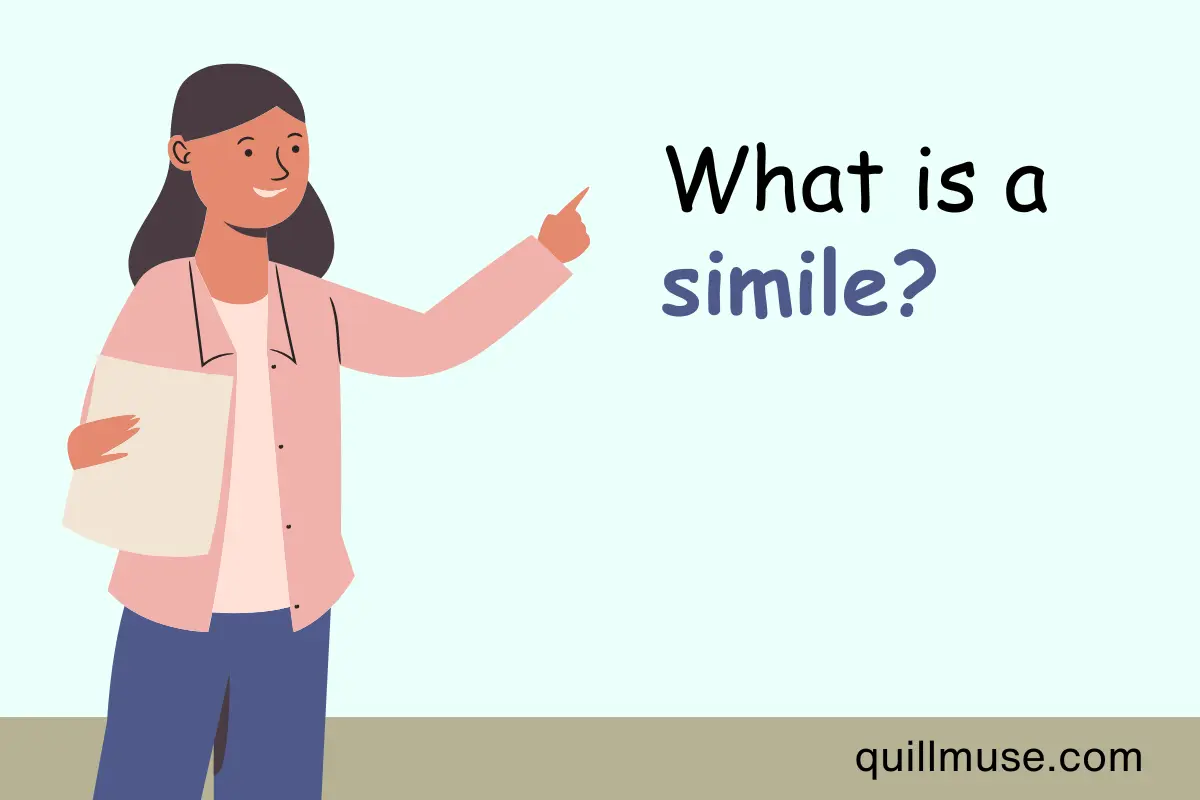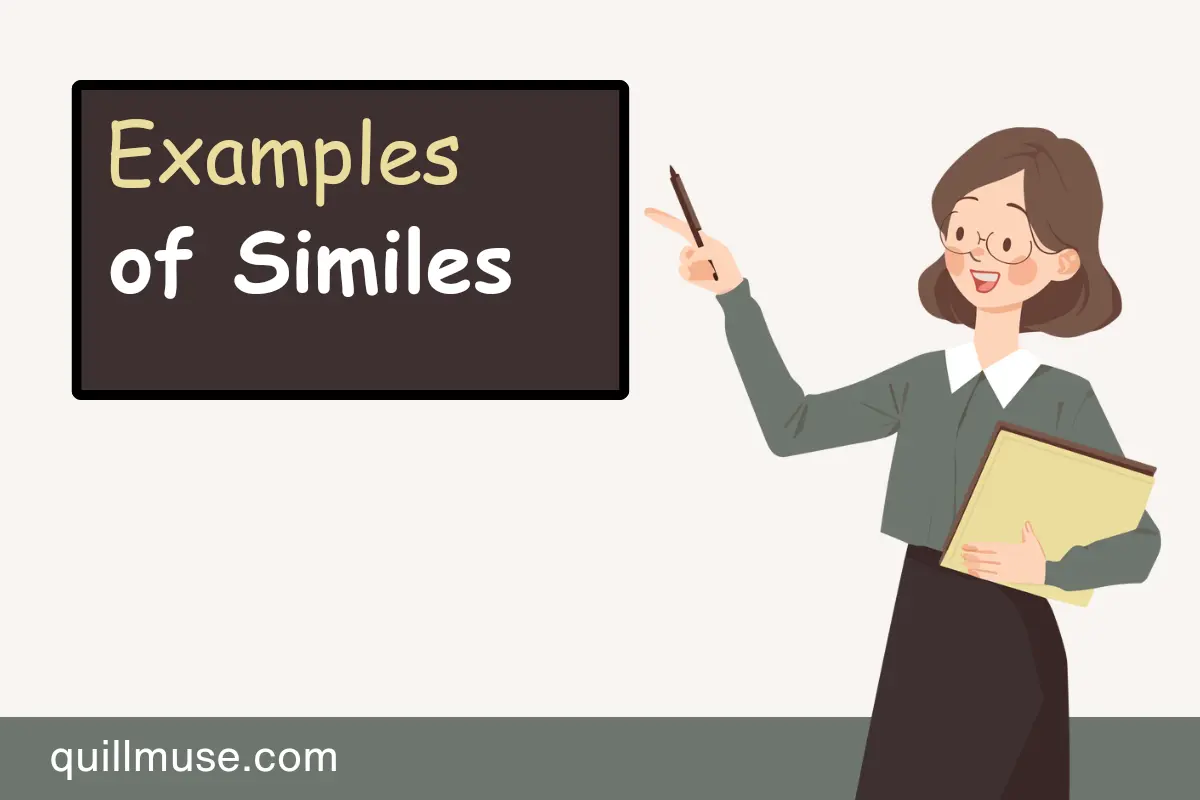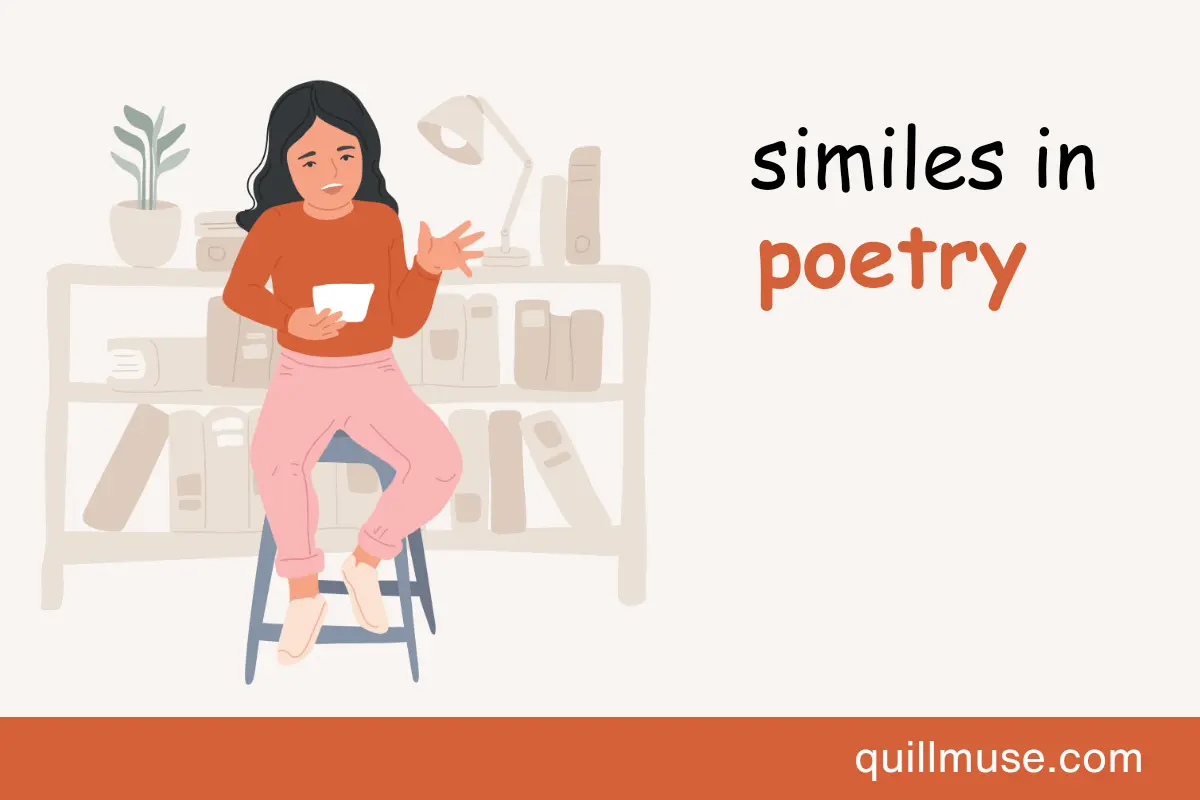What is a Simile? Definition, Meaning, Types, and Examples
Learn about similes in literature, their definition, meaning, types, and examples. Discover how similes enhance language by comparing different things vividly.

Zannat Mou
Last updated on Jun 23rd, 2024

When you click on affiliate links on QuillMuse.com and make a purchase, you won’t pay a penny more, but we’ll get a small commission—this helps us keep up with publishing valuable content on QuillMuse. Read More.
Table of Contents
Similes are basic stylistic devices that make the language more interesting and colorful and descriptions more vivid and lively. A simile is a figure of speech comparing two unlike things that are often introduced by like or as. This instrument, at the same time simple and very effective, can convert trivial statements into phrases to remember, which helps people imagine or recollect certain concepts or feelings in a bearable way.
This blog post will be devoted to the explanation and meaning of similes; their various types will be uncovered, and a good number of examples will be given to show how they are used. In the end, you will not only understand the beauty of similes but also have the skills to use them in your language as well as in your writing.
Understanding the Definition and Meaning of Similes

Similes form the essence of similes and are employed to compare two things that are entirely different, enrich descriptions, and explain meanings.
By making use of the words “like” or “as’,’ similes establish a very clear parallel between the attributes of one thing and those of another (and this other may be an unlike) entity. This bond makes it possible to picture something in a way that many people can easily understand without having experienced the same thing, or to convey or express complex emotions in a relatable way.
The basic construction of a simile is made up of a tenor (the subject being described) and a vehicle (the object to whom the subject is compared). For example, in the simile “as brave as a lion,” “brave” is a tenor, and “lion” is a vehicle. This comparison brings out the great resemblance between how brave a person is and the lion’s courage, known worldwide, so that his or her quality is expressed in a detailed way.
Similes are essential for using figurative language. The role of similes is such that they can make abstract or complex ideas more concrete. They are employed in all types of communications, starting from ordinary talks and up to literature, poetry, and advertising. Similes in literature do the work of embellishing the story by creating hidden meaning and aesthetic appeal. They also perform a very vital role in everyday language, which is helping people to express themselves vividly with both thoughts and emotions.
By comprehending similes and their use, you come closer to an expressive, more influential way of communicating. Whether you are telling a creative story or having just an informal talk, a smile can make your words more understandable and engaging, thus giving them a spark to be easily remembered.
The Basic Structure of a Simile
In the case of a simile, it has a simple structure that consists of two major parts: the tenor and the vehicle. The tenor is the subject that the description is about, while the vehicle is the object that serves as a comparison with the subject. This kind of comparison connection can be created by the usage of the words “like” or “as,” which are very important in the simile formation process.
Let’s take an example to explain this point: “Her smile is like sunshine.” In this case, “her smile” is tenors, and “sunshine” is vehicles. The word “like” acts as a bond between them, so we know that a smile shares things with sunshine, such as brightness and warmth. That clear structure gives similes the ability to employ rich pictures and subtle meanings adeptly.
Another example is the simile “He is as brave as a lion.” The tenor here is “he,” the vehicle is “a lion,” and the connecting word is “as.” This simile gives you the idea that his bravery equals the known courage of a lion, which in turn makes it easier to understand and picture.
Similes can indeed be multi-purpose and are capable of suiting different contexts and tones, thereby being very expressive. They can be as simple as “busy as a bee” or quite involved, such as “her voice was like a melody in the night.” Despite all the differences in their elaboration, they will always possess a clear and straightforward structure, helping to compare things effectively.
One important point to consider that makes similes distinct is the use of “like” or “as,” whereby the comparison is explicitly signaled to the reader or listener. This clarity is what gives similes an edge over metaphors, because metaphors do their implied comparisons more subtly by saying that one thing is another without using “like” or “as.”.
A good comprehension of a simile’s basic structure makes communication more effective; it also enriches both written and spoken language. Similes, by likening one thing to another, can do the job of representing complex ideas, conveying certain feelings, and creating clear visual pictures, which in turn makes descriptions more lively, interesting, and thus memorable.
Types of Similes
Similes come in different varieties, for each has a specific role in enriching the language of description. There are eight types of similes that you can use to help you explain things more clearly:
1. Common Similes
These serve to further clarify ideas and are more detailed compared to the common similes. They focus on a specific part of the image and give it an insightful explanation through a comparison with something else. One may say “as blue as that famous robot on TV” instead of “as blue as that basketball.”.
2. Descriptive Similes
With the similes mentioned here, their purpose is to give a clear picture, which is usual in literature and poetry. They also help to do so through vivid descriptions. Thus, they serve the purpose of making sure that the reader has an elaborate mental picture of what is being described. As an example, “The clouds were like cotton candy” or “Her eyes sparkled like diamonds.” The sensory-descriptive simile deepens the sensory experience using visual, auditory, gustatory, tactile, or olfactory imagery.
3. Epic Similes
These are extended comparisons that develop over many lines, also known as homeric similes. They are detailed and elaborate, mainly in epic poetry, which imparts them with depth and majesty. A case in point from Homer’s “The Iliad” compares soldiers to lions attacking sheep, elaborating the image to bring out the ferocity and chaos of the war.
4. Humorous Similes
Such similes are sometimes inserted not for comparison’s sake but rather to describe and make it humorous. It’s their purpose to exaggerate or/and use completely unexpected comparisons in most of the cases. Like “as awkward as a cow on roller skates” or “as useless as a screen door on a submarine,” humorous similes do the trick of lightening the tone, which could be related and enjoyable to readers.
5. Negative Similes
These similes tell you how one thing is not like another, and they usually do it to show some quality. They are quite rare, but they can impress a lot. For example, “He was as unlike his brother as day to night” or “She moved through the crowd like a ghost, unnoticed and unseen.” Negative similes can create a strong contrast, adding to the singularity of the subject.
6. Cliche Similes
Such comparisons are overworked so much that they lose their intended meaning. Although they may be easily grasped and serve an explanation well, they lack novelty. such as “as cool as a cucumber” or “as quiet as a mouse.” Writers usually try to steer clear of clichéd similes, which helps keep their language interesting and fresh; however, clichés can still do the trick in conversations or contexts familiar to you.
7. Original Similes
These types of similes serve the purpose of being original and fresh, giving a new angle, or something unexpected. comparison. These types are specially created to be outstanding and let you gain an appealing impression. “Her laughter was like a bubbling brook, refreshing and clear.” is just one instance that clarifies this type of simile. This kind of simile shows creativity, which can make descriptions more memorable and impressive.
8. Complex Similes
These similes fall under this category and are a bit more complex in the sense that they may involve basing one thing on another using multiple layers or just an abstract concept. Such kinds of similes can be those that are quite interesting to read and dig into the depth of the writing. If we say, “His thoughts were like a maze, twisting and turning with no clear path,” we mean that a complex simile requires more thinking about its comparison and the possible consequences of it.
Each simile type has its role to play, be it explaining, enhancing, amusing, or getting one to think deeper. By knowing and using these different types of similes, the writers can enrich their language, make their descriptions more vivid, and interact with their readers more effectively.
Common Examples of Similes in Everyday Language

Similes serve the purpose of making comparisons easier and more vivid for the listener by using language that creates mental images. Provided below are five examples of similes in everyday language:
1. As busy as a bee
The point of this simile is to show how much a person does by how diligent one is; it could mean that you are very busy and hardworking.
2. As blind as a bat
This analogy shows the poor eyesight of someone or that a person can’t see anything; it is based on the fact that bats depend more on echolocation than vision.
3. As brave as a lion
The simile compares someone’s courage to that of a lion, which is famous for its fearless nature, implying that the person is very brave.
4. As light as a feather
This phrase is deployed when alluding to the fact that something is extremely lightweight by directly comparing it to the negligible weight of a feather.
5. As stubborn as a mule
It’s this simile that likens the stubbornness of a person to that demonstrated by a mule, which everyone knows is very headstrong and just won’t listen.
These familiar similes are easily comprehended and employed since they are based on general or common characteristics, which in turn help to enliven language and get the message across.
How Similes Differ from Metaphors
Smiles and metaphors are different from each other. Similes and metaphors are both devices of language that, when used correctly, help you make effective comparisons, but the way and impact they have is what makes them different.
1. Use of connecting words
In similes, two things are compared directly using the words “like” or “as” (e.g., “Her smile is like the sun”).
Metaphoric comparison is made directly without using the words “like” or “as” (e.g., “Her smile is the sun”).
2. Directness of Comparison
Similes, by suggesting that one thing is like another thing, imply different degrees of comparison.
Metaphors imply comparison, blending the characteristics of two things more subtly.
3. Imagery and Impact
Similes vividly explain by likening the unfamiliar to the familiar; hence, descriptions become more vivid as well as easier to empathize with.
On the other hand, metaphors can conjure visually impressive and emotionally touching pictures, sometimes tending to express deeper or more complicated matters.
4. Usage and Frequency
Similes are commonly used in the everyday language of many people and are therefore well understood.
The use of metaphors is also prevalent, although they are often found in works of literature and poetry only to express ideas that are more complex, subtle, or abstract.
5. Flexibility
Similes, being of a fixed structure, always use “like” or “as” for the comparison.
Metaphors are, however, more flexible, and their extension or mingling can only do justice to creating imagery that is indeed richer and more complex.
Similes in Literature: Enhancing Descriptive Writing
Similes are a great weapon in literature that significantly boosts descriptive writing, which is full of vivid and understandable images. Sometimes similes help highlight literary themes. This is how similes help to achieve this goal of making literary descriptions more engaging and effective:
1. Creating vivid imagery
Similes play a great role in helping readers visualize better scenes, characters, and emotions. By comparing an element of the story with something well-known, writers can draft a more detailed picture in the reader’s mind. For instance, “The lake shimmered like a thousand diamonds” immediately gives you a clear mental picture of what kind of surface that is.
2. Enhancing emotional impact
Similes are one of the techniques used to make a story more touching. By comparing well-known experiences or objects among people, writers can achieve a much deeper emotional effect. As an illustration, “He felt as lonely as a deserted island” deeply conveys the feeling of isolation.
3. Creating memorable writing
Effective similes leave a long-lasting impression on the readers, even after they have read the story. A well-drawn simile can be one of the memorable parts of a story, hence adding to its impact that lasts forever. For instance, “Time crawled like a snail” effectively and remarkably portrays the slowness of time.
4. Character development
Similes are also great tools to develop the personality of a character. By comparing the traits or actions of characters to well-known images, writers can disclose more about their personalities and emotions. For example, “He was as stubborn as a mule” at once implies a character who is headstrong, obstinate, or swaggery and resistant to change.
5. Add depth and layers
Thus, similes add richness to the text by creating those extra layers of meaning. These provide writers with the possibility of depicting many planes of a character or a setting in just one line. For example, “Her eyes were like windows to her soul” gives off transparency and depth, so it means that his or her emotions and thoughts are easy to read.
The Role of Similes in Poetry

In poetry, similes are very important since they help to boost the expressive and evocative side of a poem, which is the figurative part of it. Here are five key roles in how similes help to grow poetry:
1. Creating vivid imagery
Similes are key to creating vivid images, which aid poets in bringing sensory experiences and making vivid pictures in the reader’s mind. Comparing similes in poetry to the nature of elements, emotions, or even abstract ideas or plans for objects or experiences makes the poetry more visually dynamic.
For example, in “Her laughter bubbled like a brook,” one can almost see the sound and movement of laughter, just as with the gentle flow of a brook.
2. Expressing emotions
Emotions can be intricately knotted and demanding to depict explicitly. The use of similes gives poets the ability to express emotions more graphically and touchingly. Everyone thinks about solid objects or physical feelings; it is easier to perceive the perceptual side of the issue. By doing this, readers will become emotionally connected to the poem. For example, “His heart pounded like a drum” visibly depicts the intensity of nervousness or excitement.
3. Adding depth and complexity
Similes add to the meaning of a poem by deepening its interpretation through hidden similarities and connections. Similes enable poets to do this by using analogies, which help to express more difficult ideas or philosophical themes. Thus, it makes the poem more elaborate and profound. An example is “Time stretched like an endless desert,” which gives a comprehension of the vastness and seeming eternity of time.
Conclusion
Finally, similes form a significant group of expressive means that enrich the language by directly comparing the objects using “like” or “as.” They improve descriptions, explain abstract ideas, and create vivid pictures, which make communication more interesting and clear. Different kinds, such as common, descriptive, and humorous similes, serve various purposes in the scope of everyday language and literature.
By learning how to use similes effectively, writers and speakers can make their expressions more lasting, great, and emotionally touching while deepening the audience’s connection to them, thus improving their overall communicative quality.
FAQs
What is a simile?
A simile is a figure of speech that implicitly or explicitly compares two different things, using “like’ or “as”. It serves to display a vivid image and makes the description more comprehensible and easier to relate to.
How does a simile differ from a metaphor?
In similes, it is explicitly pointed out that one thing is being compared to another; this can be carefully done with the words ‘as’ or ‘like’. In metaphors, there is no overt comparison; instead, you say that something ‘is’ something else. A simile goes thus: “Her hug was like a warm blanket,” while a metaphor states, “Her embrace was a warm blanket.”
What is the role of similes when it comes to the improvement of everyday communication?
Similes make everyday communication more vivid and relatable by drawing clear and relatable comparisons, which help convey ideas and feelings more effectively.
Are similes capable of being overused?
Certainly, the overuse of similes, particularly those that are clichéd, can make writing quite predictable and less impactful. Judicious and creative use of similes is important so that you can keep them effective.
How we've reviewed this article
Our content is thoroughly researched and fact-checked using reputable sources. While we aim for precision, we encourage independent verification for complete confidence.
We keep our articles up-to-date regularly to ensure accuracy and relevance as new information becomes available.
- Current Version
- Jun 23rd, 2024
- Jun 17th, 2024



